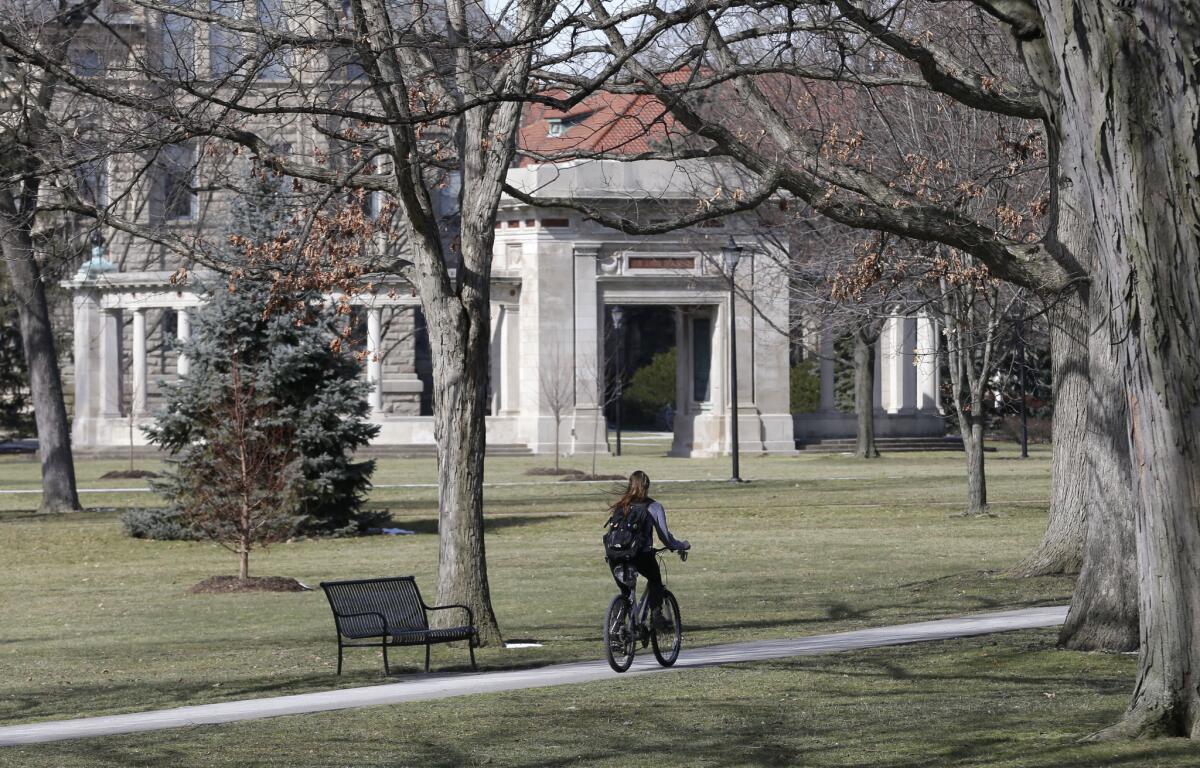Colleges as country clubs

- Share via
My daughter is a junior in high school, so I’ve spent part of this spring making that upper-middle-class pilgrimage known as “the college tour.”
But as we were led across sweeping lawns by tour guides walking backward, I found myself thinking less about my daughter’s looming college experience and more about how different her life will be after she graduates.
I’ve also been thinking about “Girls,” the television series about four young women trying to make ends meet in New York. Three of them are depicted as recent graduates of Oberlin, which is also the alma mater of “Girls” creator and lead actress Lena Dunham.
And if you take a look at Oberlin, or at almost any college or university, you’ll get a good idea of why these “girls” are struggling in the real world. Put simply, today’s American colleges shower students with absurdly lavish bills of goods and services. No wonder it’s so hard for them to pay their own bills when they get out.
To be fair, Oberlin’s campus is less over the top than many others. But even so, it recently opened a $24-million music building featuring a glass walking bridge and a naturally lit “Sky Lounge.” And the school’s sport facilities include a 25-foot climbing wall and a 360-square-foot “bouldering cave.”
Other colleges outfit their dormitories with hot tubs, HD television sets and more. At USC, the recently opened West 27th Place luxury apartment complex boasts a walk-in tanning booth — called the Sundazzler — along with decorative fountains, tiled roofs and landscaped sidewalks. Its kitchens feature granite countertops and ice makers, just in case someone feels like mixing a margarita.
Granted, the complex is not official university housing, but it was built to serve USC students. Its developer, American Campus Communities, which describes itself as “the nation’s premier owner and manager of luxurious, academically oriented student housing,” advertises the complex as “an off-campus student community that is built specifically with you, the college student, in mind.” Since when do college students need “luxurious” student housing?
And the bling is likely to be even greater at less selective institutions, as a recent University of Michigan study found. Students applying to these colleges are more likely to make their decisions based on a school’s amenities, not its academics. Perhaps that’s why a new residence hall at St. Leo University in Florida boasts a 2,100-gallon aquarium and a “relaxation room” with big-screen televisions and “spherical nap pods.”
At the University of Arizona, a student journalist recently wrote in defense of the swank private luxury apartments catering to students. “If you’re not going to an Ivy League University,” he wrote, “then why not have some fun?” In high school, the journalist noted, he had attended a summer program at an Ivy school: Yale. Its stone buildings were “beautiful,” he recalled, “but living in them was a nightmare.”
Actually, Yale has spent more than $4 billion on renovations and construction since 2001. But its older buildings — especially its dormitories — remain relatively spartan. Ditto for many dorms at Harvard, Princeton and other elite schools, and that’s partly intentional.
Princeton’s dormitories were the brainchild of Woodrow Wilson, who was president of the university before he entered politics. Wilson worried about campus elitism and felt that too many students were housed in off-campus “eating clubs,” which divided students from one another and diverted them from the life of the mind. So he reconfigured the campus as “a walled city against materialism and all of its works,” as one architect wrote, built around solid but austere student residences.
At all-female Smith College, meanwhile, modest living quarters would illustrate “what the human spirit can do when unhampered either by deprivation or by excess,” as one dean of the college wrote.
After World War II, when the GI Bill allowed millions of returning veterans to attend college, they lived in hastily constructed Quonset huts or trailer parks. And when postwar prosperity and federal loans sparked another enrollment boom in the 1960s and 1970s, universities built drab cinder-block and concrete buildings to house newcomers.
Only in recent years did colleges start to resemble country clubs, with a few classrooms thrown in. Competing for students, universities also competed to see who could build the nicest dorms, gyms and stadiums. The expenses were passed on to students, of course, who met rising tuition costs by taking out more loans. Student debt has doubled in the last decade, topping $1 trillion, which is more than the total amount that Americans owe on their credit cards.
To be sure, some of the new college construction is bankrolled by individual donors, who often prefer to fund buildings that can bear their names rather than scholarships or research. But private gifts to universities plummeted after the 2008 recession, while construction picked up. Between 2010 and 2012, colleges and universities spent $22 billion on new facilities, or twice as much as they were spending a decade earlier. And with fewer private donations, some colleges are taking on debt to fund construction, debt that is likely to be passed on to students and their families.
What if universities declared a moratorium on new construction? It’s not as crazy as it sounds. At my own institution, New York University, faculty and students have been protesting a projected $6-billion expansion. It’s likely to add to students’ debt, which is already 40% higher than the national average. And lots of nice new stuff won’t prepare them for life after graduation, which won’t be nearly as cushy.
That brings us back to Lena Dunham and the cast of “Girls,” who are learning these lessons the hard way. “This is the first generation that can expect to do less well than their parents, and that’s a terrifying prospect,” Dunham told Oberlin’s alumni magazine last spring. But you wouldn’t know that from looking at our colleges, which have continued to spend as if there’s no tomorrow. And that might be the most terrifying prospect of all.
Jonathan Zimmerman teaches history and education at New York University. He is the author of “Small Wonder: The Little Red Schoolhouse in History and Memory.”
More to Read
A cure for the common opinion
Get thought-provoking perspectives with our weekly newsletter.
You may occasionally receive promotional content from the Los Angeles Times.






